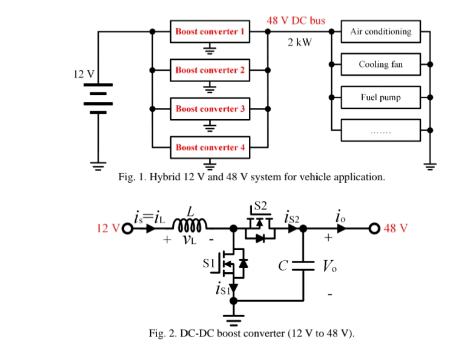EPE3301: Perform theoretical design and calculation for the boost converter (Fig. 2). Specify any assumptions considered in your calculation: Power Electronics Assignment, SIT, Singapore
| University | Singapore Institute of Technology (SIT) |
Coursework 1 (Group): Design and Simulation of DC-DC Boost Converter
Hybrid and fully electric vehicles are the current trends in automotive industry. To reduce CO: emission, 48 V DC system has been proposed by European automotive industry. This allows the same electrical power being delivered at reduced current that minimised resistive losses. The shift to 48 V also allows greater power delivery.
To avoid substantial change to the automotive electrical system, the first step is to implement 48 V alongside 12 V we have used for decades. The strategy is to move all power-hungry components to the 48 V side depicted in Fig. 1. Four identical boost converters shown in Fig. 2 are connected in parallel to share the rated power of 2 kW.

cta_question_21
This coursework aims to design a 500-W DC-DC boost converter (Fig. 2) for the abovementioned application. The design should fulfil the following specifications:
- Input voltage: 12 V
- Output voltage: 48 V
- Output power: 100 W to 500 W
- Mode of operation: continuous conduction mode (CCM)
- Operating frequency: 100 kHz
- Inductor current ripple: less than 1% of average inductor current at rated power
- Capacitor voltage ripple: less than 1% of average capacitor voltage at rated power
You are required to complete the following tasks in a group of three (free to choose your group members):
(a) Perform theoretical design and calculation for the boost converter (Fig. 2). Specify any assumptions considered in your calculation.
(b) Validate your design by simulation considering ideal components. Simulation can be conducted with Matlab Simulink, PSIM, PLECS or other relevant circuit simulation software.
(c) Choose a suitable power switch (S} and S2 in Fig. 2) for your design. Some useful component distributors for finding power switches are:
RS Componnets: https: ”sg.rs-online.com/web‘
Element] 4: https:‘’sg.element]4.com’
Mouser Electronics: https://www.emouser.sg!
(d) Calculate the power losses for switches $1 and S2 under rated power (500 W), based on the datasheet information. Specify any assumptions considered in your calculation.
(e) Model the power switches $1 and S2 according to the datasheet information for simulating the boost converter considering practical power switches (non-ideal power switches). Validate the power losses calculated in
(d) and analyse the efficiency of the boost converter. Perform a comprehensive simulation study to validate your design in accordance with the specified requirements/specifications.
(f) Write a report to thoroughly discuss your design, result, and analysis.
Buy Custom Answer of This Assessment & Raise Your Grades
Excel in EPE3301 Power Electronics Assignment with our specialized expertise. Benefit from our dedicated assignment help in Singapore and access affordable assistance through our Cheap Homework Help services. Singapore students, optimize your academic journey by investing in our experts' personalized assistance.
- HRM335 ECA: Exploring Thought Leadership: Influence, Reflection, and Competencies
- HBC251 ECA: The Nexus of Religion and Hate: A Sociological Exploration
- ELG101 ECA: Exploring Singlish: An Infographic and Reflection:- Discovering Language
- MKT371 ECA: Data Analysis and Strategic Insights for Kimberly-Clark
- MN3496K Essay: Cluster, Small Business & International Entrepreneurship
- HBC207 TMA02: Invisibility and Marginalization in Singaporean Literature: Why Read?
- BUS356 Group Assignment: Contemporary Financial Accounting
- NCO113 TMA01: Teamwork in the Modern Workplace Semester 2025
- ECE316 ECA: Classroom Inquiry and Action Research: A Research-Based Assessment
- BPM115 TMA02: Sustainable Materials Feasibility Study for a Cross-Country Bridge
UP TO 15 % DISCOUNT

